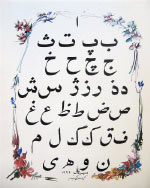
The Iranian (or persian) calendar is also named Solar Hejri and is currently used in Iran and Afghanistan as the main official calendar. This calendar is an astronomical solar calendar and one of the longest chronological records in history. Beginning each year on the vernal equinox as precisely determined by astronomical observations from Tehran (or the 52.5°E meridian, which also defines IRST), this makes it more accurate than the Gregorian Calendar in being synchronized with the solar year, but harder to work out when a particular date would occur before the New Year preceding that date.
The Jalali calendar (Persian: گاهشماری جلالی), an ancestor of the Iranian calendar, was introduced on 15 March 1079 by the Seljuk Sultan Jalal al-Din Malik Shah I, based on the recommendations of a committee of astronomers, including Omar Khayyam, at the imperial observatory in his capital city of Isfahan. Month computations were based on solar transits through the zodiac, a system integrating ideas from the Surya Siddhanta (India, 4th century).Later, some ideas from the Chinese-Uighur calendar (1258) were also incorporated. It remained in use for eight centuries.
Last change of the official Iranian calendar was in 1925. The current Iranian Calendar year is AP 1387 (AP = Anno Persico/Anno Persarum = Persian year). The Iranian year usually begins on 21 March of the Gregorian calendar. You can calculate the gregorian year by adding 621 or 622 (depending on the time of the year) to an Iranian year.
Year
The Iranian calendar year begins at the start of Spring in the northern hemisphere: on the midnight between the two consecutive solar noons which include the instant of the Northern spring equinox, when the sun enters the northern hemisphere. If between two consecutive noons the sun's altitude rises through its equinoctial altitude, then the first noon is on the last day of one calendar year and the second noon is on the first day (Nowruz) of the next year. The calendar has 12 months with Persian names.
Months
The first day of the calendar year is also the day of the greatest festival of the year in Iran, Afghanistan and surrounding regions, called Nowruz (two morphemes: know (new) and rooz (day), meaning "new day").

Days of the week
In the Iranian calendar, every week begins on Saturday and ends on Friday. The days of the week are called:
- shanbeh (Saturday, شنبه )
- yekshanbeh (1 + Saturday = Sunday, یکشنبه)
- doshanbeh (2 + Saturday = Monday دوشنبه)
- seshanbeh (3 + Saturday = Tuesday, سه شنبه)
- chahårshanbeh (4 + Saturday = Wednesday, چهارشنبه)
- panjshanbeh (5 + Saturday = Thursday, پنجشنبه)
- jomhe (Friday, جمعه originally in Arabic) or ådineh (آدینه) (in Persian)
In most Islamic countries, jum'a is the holiday.
Calculating the day of the week is easy, using an anchor date. One good such date is Sunday, 1 Farvardin 1372, which equals 21 March 1993. Assuming the 33-year cycle approximation, move back by one weekday to jump ahead by one 33-year cycle. Similarly, to jump back by one 33-year cycle, move ahead by one weekday.
As in the Gregorian calendar, dates move forward exactly one day of the week with each passing year, except if there is an intervening leap day when they move two days. The anchor date 1 Farvardin 1372 is chosen so that its 4th, 8th, ..., 32nd anniversaries come immediately after leap days, yet the anchor date itself does not immediately follow a leap day.
Seasonal error
The is an error in the iranian seasonal calendar. The error shifts by about 1/4 day per year, and is corrected by a leap year every 4th year regularly, and one 5 year leap period to complete a 33-year cycle. One can notice a gradual shift upwards over the 500 years shown. The Gregorian calendar, introduced in 1582, is almost as accurate in the long term, but has larger swings of seasonal errors over centuries.
